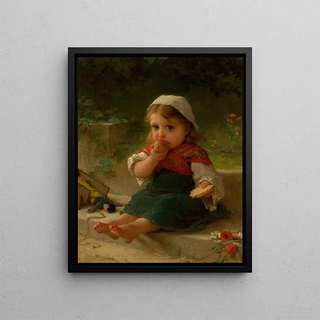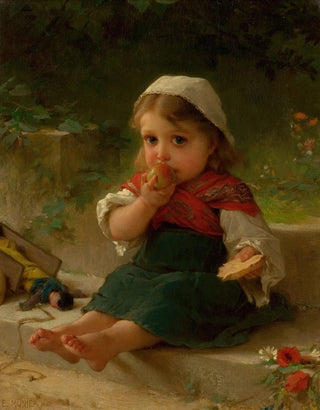Art print | Portrait of a Child - Émile Munier


View from behind

Frame (optional)
In the fascinating universe of art, some works manage to capture the innocence and fragility of childhood with such depth that they transcend time. "Portrait of a Child - Émile Munier" is one of those iconic pieces that evoke palpable tenderness. This painting, created by Émile Munier, a renowned French painter of the 19th century, immerses us in a frozen moment where childhood innocence intertwines with the artist's technical virtuosity. The piece, both delicate and vibrant, invites the viewer to an introspective contemplation, revealing the emotions and thoughts hidden behind a child's smile.
Style and uniqueness of the work
Munier's style is distinguished by its striking realism and its ability to bring life to the subjects he depicts. In "Portrait of a Child," the fineness of the details immediately draws the eye. The textures of the clothing, the softness of the skin, and the sparkle in the eyes are rendered with precision that testifies to the artist's skill. The colors, both soft and luminous, create a warm, almost intimate atmosphere. The child, at the center of the canvas, seems to emanate an aura of purity, capturing the very essence of childhood. The gaze of the young model, both curious and contemplative, questions us and connects us to a universe where the simplicity of childhood pleasures reigns supreme. By choosing to depict a child, Munier offers us a moment of grace, an enchanted pause amid the tumult of the world.
The artist and his influence
Émile Munier, born in 1840, was an artist whose career was marked by a constant quest for beauty and harmony. Raised in an artistic environment, he was influenced by the great masters of his time but developed a style that was uniquely his own. His work is often associated with academic painting, but he also incorporated elements of the Impressionist movement, particularly in his approach to light. Munier was able to capture the human soul through his portraits, and his approach to childhood is particularly meaningful.

Matte finish

View from behind

Frame (optional)
In the fascinating universe of art, some works manage to capture the innocence and fragility of childhood with such depth that they transcend time. "Portrait of a Child - Émile Munier" is one of those iconic pieces that evoke palpable tenderness. This painting, created by Émile Munier, a renowned French painter of the 19th century, immerses us in a frozen moment where childhood innocence intertwines with the artist's technical virtuosity. The piece, both delicate and vibrant, invites the viewer to an introspective contemplation, revealing the emotions and thoughts hidden behind a child's smile.
Style and uniqueness of the work
Munier's style is distinguished by its striking realism and its ability to bring life to the subjects he depicts. In "Portrait of a Child," the fineness of the details immediately draws the eye. The textures of the clothing, the softness of the skin, and the sparkle in the eyes are rendered with precision that testifies to the artist's skill. The colors, both soft and luminous, create a warm, almost intimate atmosphere. The child, at the center of the canvas, seems to emanate an aura of purity, capturing the very essence of childhood. The gaze of the young model, both curious and contemplative, questions us and connects us to a universe where the simplicity of childhood pleasures reigns supreme. By choosing to depict a child, Munier offers us a moment of grace, an enchanted pause amid the tumult of the world.
The artist and his influence
Émile Munier, born in 1840, was an artist whose career was marked by a constant quest for beauty and harmony. Raised in an artistic environment, he was influenced by the great masters of his time but developed a style that was uniquely his own. His work is often associated with academic painting, but he also incorporated elements of the Impressionist movement, particularly in his approach to light. Munier was able to capture the human soul through his portraits, and his approach to childhood is particularly meaningful.






